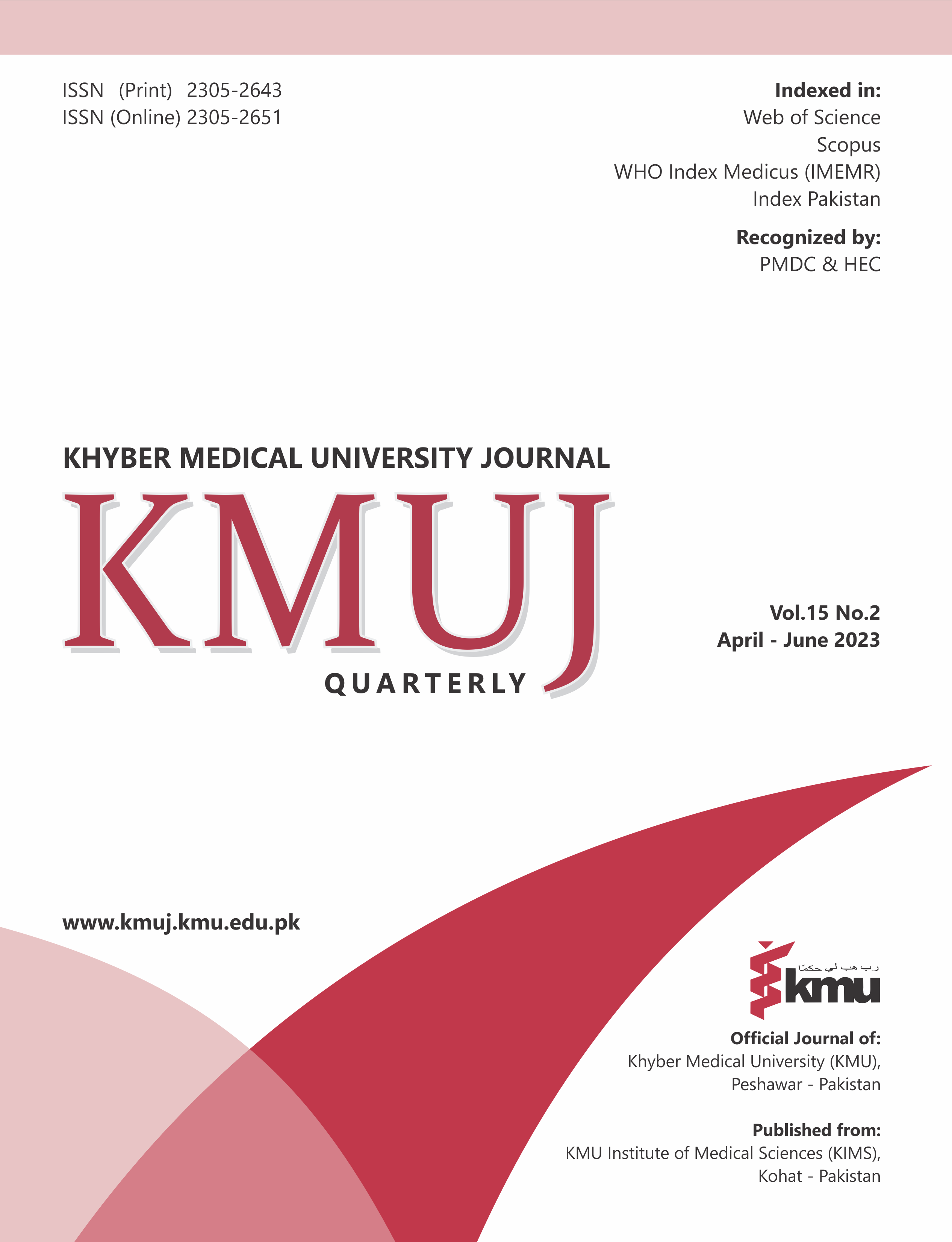Association of asthenopia with refractive errors in madrassa students
Main Article Content
Abstract
OBJECTIVE: To determine the association of presenting clinical features of asthenopia in madrassa students with different refractive errors.
METHODS: This cross-sectional study was conducted from September-November 2022 at different Madrassas in Lahore, Pakistan. Study was performed on a sample of 108 patients, who had different refractive difficulties. Informed consent was taken from the patients aging ≥18 years and from parents/ guardians of patients aging <18 years. A self-designed questionnaire was used to gather the data of all patients. Patients with different refractive errors within the range of 8-25 years were taken into consideration. Data were analyzed by using SPSS version 25. A statistically significant p-value of 0.05 was considered.
RESULTS: Out of 108 patients, 38 (35.2%) were males and 70 (64.8%) were females. Majority (n=59; 54.6%) were >16 years of age. Common asthenopic symptoms included hazy vision (n=106; 98.1%), headache (n=93; 86.1%), discomfort (n=79; 73.1%), pain (n=76; 70.4%) and eye strain (n=72; 66.7%). Common refractive errors were myopia (n=59; 54.6%), hypermetropia (n=25; 23.2%) and astigmatism (n=24; 22.2%). Severity of refractive errors was mild in majority of cases of myopia (n=24/59; and hypermetropia (n= and moderate in astigmatism (n=16; 64%). Headache, eye strain and blurring of vision had significant association with myopia, hypermetropia, and astigmatism.
CONCLUSION: Myopia and hypermetropia are the most common refractive errors; hazy vision and headache are the common asthenopic symptoms. There is a strong association between asthenopic symptoms and refractive errors.
Article Details
Work published in KMUJ is licensed under a
Creative Commons Attribution 4.0 License
Authors are permitted and encouraged to post their work online (e.g., in institutional repositories or on their website) prior to and during the submission process, as it can lead to productive exchanges, as well as earlier and greater citation of published work.
(e.g., in institutional repositories or on their website) prior to and during the submission process, as it can lead to productive exchanges, as well as earlier and greater citation of published work.
References
Hashemi H, Saatchi M, Yekta A, Ali B, Ostadimoghaddam H, Nabovati P, et al. High prevalence of asthenopia among a population of university students. J Ophthalmic Vis Res 2019;14(4):474-82. https://doi.org/10.18502/jovr.v14i4.5455
Afzal F, Hussain A. Correlation of Asthenopic Symptoms with Refractive Errors in Young Adults. Ophthalmol Pak 2019;9(3):7-11.
Twenge JM, Campbell WK. Associations between screen time and lower psychological well-being among children and adolescents: Evidence from a population-based study. Prev Med Rep 2018;12:271-83. https://doi.org/10.1016/j.pmedr.2018.10.003
Uchino M, Schaumberg DA, Dogru M, Uchino Y, Fukagawa K, Shimmura S, et al. Prevalence of dry eye disease among Japanese visual display terminal users. Ophthalmology 2018;115(11):1982-8. https://doi.org/10.1016/j.ophtha.2008.06.022
Xu Y, Deng G, Wang W, Xiong S, Xu X. Correlation between handheld digital device use and asthenopia in Chinese college students: a Shanghai study. Acta Ophthalmol 2019;97(3):e442-7. https://doi.org/10.1111/aos.13885
Heus P, Verbeek JH, Tikka C. Optical correction of refractive error for preventing and treating eye symptoms in computer users. Cochrane Database Syst Rev. 2018 Apr 10;4(4):CD009877. https://doi.org/10.1002/14651858.CD009877.pub2
Bourne RRA, Flaxman SR, Braithwaite T, Cicinelli MV, Das A, Jonas JB et al. Magnitude, temporal trends, and projections of the global prevalence of blindness and distance and near vision impairment: a systematic review and meta-analysis. Lancet Glob Health. 2017;5(9):e888–97. http://dx.doi.org/10.1016/S2214-109X(17)30293-0 PMID:28779882
Kong L, Fry M, Al-Samarraie M, Gilbert C, Steinkuller PG. An update on progress and the changing epidemiology of causes of childhood blindness worldwide. J AAPOS. 2012 Dec;16(6):501–7. http://dx.doi.org/10.1016/j.jaapos.2012.09.004 PMID:23237744
Zahra T, Hussain I, Munawar S, Baig S, Bokhari NM. Prevalence of refractive errors and the factors related to it among madrassa students in district Sialkot. Professional Med J 2020;27(1):143-51. https://doi.org/10.29309/TPMJ/2019.27.01.4006
Rehman AU, Sughra U, Kausar S, Riaz A, Suleman M. Uncorrected Refractive Error among Male Students of Madrassas in Rawalpindi–Pakistan. Pak J Ophthalmol 2022;38(2). https://doi.org/10.36351/pjo.v38i2.1327
Kuswanto V, Kurniawan F, Amita ASD. Association between Refractive Error Types and Asthenopia in Primary School Students. Majalah Kedokteran Bandung (Bandung Med J) 2021;53(3):126-31. https://doi.org/10.15395/mkb.v53n3.2236
Wang J, Zeng P, Deng XW, Liang JQ, Liao YR, Fan SX, et al. Eye habits affect the prevalence of asthenopia in patients with myopia. J Ophthalmol 2022;2022:8669217. https://doi.org/10.1155/2022/8669217
Atta Z, Arif AS, Ahmed I, Farooq U. Prevalence of refractive errors in Madrassa students of Haripur district. J Ayub Med Coll Abbottabad 2015;27(4):850-2.
Altaf A, Khalid M, Raza AH. Prevalence of Refractive Errors in Madrassa Students of Lahore. Ophthalmol Update 2018;16(2).
Lajmi H, Choura R, Achour BB, Doukh M, Amin Z, Hmaied W. Headache associated with refractive errors: Characteristics and risk factors. Revue Neurologique 2021;177(8):947-54.
